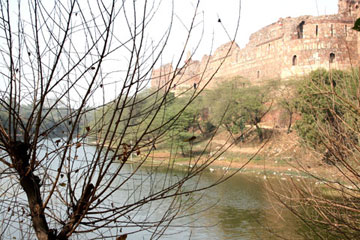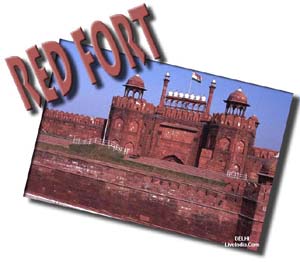
Advertise
here |
 Purana Qila (Old Fort)
Purana Qila (Old Fort)
Humayun- The Mughal Emperor
Costructed The Fort
When the second Mughal
emperor Humayun decided to make a city of his own he decided on the site
of the ancient city of Indraprastha. Humayun was quite a scholar with a
fine grasp on such matters and so it is certain that the site was chosen
deliberately. When his Sher Shah Suri overthrew him, he destroyed most
of Dinpanah (refuge of the faithful) as the city of Humayun was called
to make way for his own Dilli Sher Shahi or Shergarh. Incidentally, Humayun
was probably the only emperor in history who built a city in Delhi and
did not give it his own name – this was typical of Humayun's rather sophisticated
and dreamy character.
The Layout of The Massive
Colossal In plan the Old fort, now simply called Purana Qila by Delhites,
is irregularly orbital. The walls of the immense Qila tower down on the
road that takes one to Pragati Maidan from the height of 18m, and run on
for about 2km. It has three main gates – the Humayun darwaza, Talaqi darwaza
and Bara darwaza (which one uses to enter the fort today). The double-storeyed
gates are quite huge and are built with red sandstone. of all the gates
entry was forbidden from Talaqi (forbidden) darwaza, the northern gate.
It is not clear why this was so.
Other Attractions of
The Fort
Sher Shah Suri and his
successor could not complete the city, and when Humayun defeated Sher Shah's
son to take back his city, he did not deal with Dilli Sher shahi as the
latter had done with Dinpanah. In fact the Mughal emperor very handsomely
completed the city and even used several of the buildings like the Sher
Mandal, a rather pretty two-storeyed octagonal building. Humayun used this
as his library and, then tripped to his death from its steps. |
Excavation of Grey Ware Pottery
Several excavations have
taken place in the Purana Qila in an attempt to prove, or disprove as the
case may be, whether it is indeed the site of Indraprastha or not. Diggings
have yielded Painted Grey Ware pottery which has been dated to 1000BC.
Similar stuff has been noticed in other sites associated with the epic
Mahabharata as well, which seem to conclusively prove that this indeed
was the place where Indraprastha once flourished. These excavation have
also thrown up material, like coins, associated with the Gupta (about 4-5th
century AD) and post-Gupta ages (700-800AD) of Indian history as well.
Qila-i-kuhna Masjid
One of the most fascinating
buildings, and also one of the few that still survive, in the Purana Qila
is the Qila-i-kuhna masjid. Sher Shah Suri built it in 1541 (also see History)
and he was obviously out to make a definite style statement.
The mosque is quite a
place; its prayer hall measures 51.20m by 14.90m and has five doorways
with the 'true' horseshoe-shaped arches. Apparently the idea was the build
the whole mosque in marble, but the supply ran out and red sandstone had
to be used instead. But the builder used the material at hand very skillfully
and the result is quite spectacular – the red sandstone and the marble
contrast beautifully with each other to give the mosque a very distinctive
air. The mihrabs (prayer niches) inside the mosque are richly decorated
with concentric arches. From the prayer hall, staircases lead you to the
second storey where a narrow passage runs along the rectangular hall. The
central alcove is topped by a beautifully worked dome. In the courtyard
at one time there was a shallow tank, which had a fountain. The mosque
has an inscription which says 'As long as there are people on this earth,
may this edifice be frequented, and people be happy in it.' A noble thought
– amen to it.
The ruins of this fort
are located on a small hill which once stood on the banks of the Yamuna
river. Legend has it that the fort marked the site of Indraprastha, the
magnificent capital of the Pandavas, though the construction was carried
out by Sher Shah Suri any time between 1538 to 1545 A.D.The structure houses
a mosque which has a double-storeyed octagonal tower. It is said that the
Mughal King, Humayun, fell from the tower accidently and died. At the foot
of the hill is a lake where the Delhi Tourism has arrangements for boating
and also a sound and light show.
The location of Purana
Qila is not new to history, as the earliest reference to this site is made
in the Hindu epic, Mahabharata. Recent excavations at the fort site have
yielded painted grey ware pottery which dates back to 1000 B.C.The fact
that until 1913 there was a village within the fort called Indrapat gives
credence to the belief that Purana Qila was built on the ruins of Indraprastha.
The walls of the fort are 18 metres high at some points and there are groups
of holes arranged in patterns on the walls which were apparently meant
to be nesting spaces for birds.
The fort has three gates-
Humayun Darwaza, Talaqi Darwaza and Bara Darwaza, through which one can
enter the fort today. Inside the fort is the Kuhna Masjid built by Sher
Shah in 1541 and is considered to be a masterpiece of architecture. The
inner west wall of the building has five arched openings which are richly
ornamented in white and black marble. On a marble slab inside the mosque
is an inscription which when translated reads: ' as long as there are people
on this earth, may this edifice be frequented and people be cheerful and
happy in it'. |








